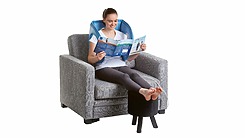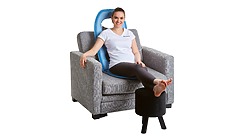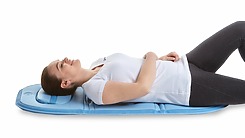Biomag - Encyclopedia - Arthritis of the spine
Arthritis of the Spine - symptoms, description and treatment

Author MUDr. Peter Bednarčík CSc.
Revision
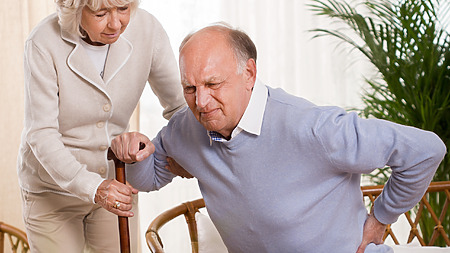
Does your spine hurt when you wake up? Do you feel relief during the day but the pain returns in the evening? These are common problems with spinal arthritis. It is an inflammatory disease of the joints in the spine. In addition to the pain, there is also stiffness in the back and, in some patients, impaired sensitivity in the limbs.
Find out what treatment options exist for spinal arthritis. How to suppress unpleasant symptoms such as pain, swelling and inflammation in this disease? Read more here.
Spinal arthritis symptoms
The main symptoms of spinal arthritis are:
- Back pain and stiffness – especially in the lower back and cervical spine,
- limited spinal mobility – the patient cannot straighten or turn completely,
- tenderness and swelling at the site of the inflamed joint,
- overall fatigue and weakness,
- impaired sensitivity in the extremities,
- headaches. [1]
Patients with arthritis of the spine may not always have the same symptoms. The type and intensity of the problems depend on the type of arthritis and the general state of health.

Only a doctor can make a correct diagnosis. Do not use this or any other article on the internet to make a diagnosis. Do not postpone seeing a doctor and addressing your medical condition in a timely manner.
Description and causes of arthritis of the spine
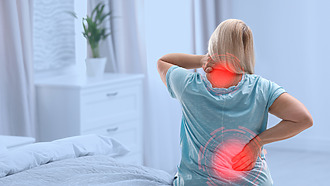
What is arthritis of the spine?
Spinal arthritis is an inflammatory disease of the joints in the spine or at the junction of the spine and pelvis. It can be related to wear and tear on the spine, autoimmune diseases or infectious diseases. Arthritis of the joints can occur in any part of the spine, but most commonly affects the cervical and lumbar spine. In some cases, the exact cause of arthritis remains unclear. [2]
Types of spinal arthritis
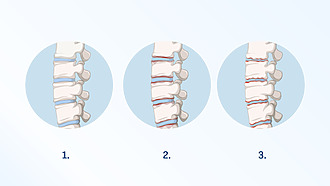
Arthritis of the spine can take many different forms. There are more than 100 different types of arthritis known. [3] The most common types include arthritis that develops with spinal osteoarthritis, rheumatoid arthritis, ankylosing spondylitis (Bechterew’s disease), psoriatic arthritis or reactive arthritis. [4]
Characteristics of Different Types of Spinal Arthritis
- Spinal osteoarthritis is a non-inflammatory degenerative disease of the vertebrae and intervertebral discs, which most often affects people in older age. Wear and tear of the articular cartilage causes pain and can lead to the development of inflammation or swelling.
- Rheumatoid arthritis is an autoimmune disease in which the immune system acts improperly against itself, resulting in inflammation in the joints. The limbs are most commonly affected, but the spine can be too.
- Ankylosing spondylitis – this disease is aslo commonly known as Bechterew’s disease. Inflammation that affects individual joints in the spine, the connection between the spine and pelvis or the ligaments between vertebrae causes pain in the lower back. Morning stiffness and fatigue may accompany it as well.
- Psoriatic arthritis is an inflammatory joint disease that accompanies psoriasis (psoriasis). Patients are usually first diagnosed with psoriasis and only subsequently develop joint pain caused by psoriatic arthritis.
- Reactive arthritis is a disease in which joint inflammation occurs in response to inflammation in another part of the body. Reactive arthritis can result, for example, from inflammation in the digestive tract or urinary tract. [5]
Diagnostics
The diagnosis of spinal arthritis is made in three basic steps.
- The doctor first asks detailed questions about the nature of the problem, the type and intensity of the back pain and other associated problems. They also need to know if you are being treated for any chronic conditions and what medications you are taking.
- The next step is a physical examination focused on the state of the musculoskeletal system and reflexes. The doctor assesses joint mobility, muscle strength, gait and range of motion when bending or turning the body.
- The third stage involves the use of imaging methods (X-ray, magnetic resonance imaging or computed tomography). The images show the extent of the damage to the spine and the condition of the surrounding tissues or intervertebral discs to be assessed.
Some patients also need laboratory blood tests to rule out or confirm other diseases with similar symptoms. [6]
Did you know?
- The stiffness and back pain in arthritis of the spine is at its worst in the morning in the first half hour after waking up.
- Degenerative changes in the spine affect most people over the age of 60. However, 85% of them report no pain or other problems. [7]
Complications when left untreated
If spinal arthritis is not treated early and correctly, various complications can develop.
- Stiffness and deformity of the spine: Chronic inflammation can cause the spine to stiffen and lose its flexibility.
- Chronic pain: untreated arthritis often leads to chronic pain.
- Limited mobility: inflammation and stiffness of the joints can severely limit the patient’s range of motion.
- Complications in other joints: apart from the spine, arthritis can also affect other joints.
Stiffening of the spine
Chronic pain
Limited mobility
Inflammation of other joints

We recommend not delaying treatment for arthritis of the spine
Do not delay treatment for arthritis of the spine, and see a specialist if you have any health problems or doubts about your health. This will prevent unnecessary health complications.
Spinal arthritis treatment
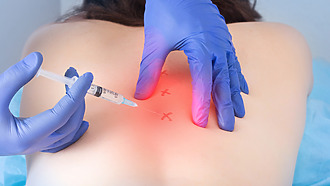
Most patients are treated conservatively to relieve spinal pain and improve mobility. Surgical treatment (spinal surgery) always poses some risk, so doctors usually combine different conservative treatment methods.
These are:
- physiotherapy (improves muscle strength, posture and range of motion),
- taking painkillers and anti-inflammatory drugs (non-steroidal anti-inflammatory drugs or corticosteroids in pill or injection form),
- other medicine to relieve specific symptoms,
- regular exercise (improves physical fitness and may relieve pain),
- weight management (being overweight or obese put excessive strain on the joints and spine),
- a change in lifestyle (doctors recommend quitting smoking and adjusting your diet).
The exact form of treatment depends on the type and severity of arthritis, the intensity of the pain and the age of the patient. Doctors also take into account the general state of health and other comorbidities. The joint damage in arthritis is irreversible, so treatment usually focuses on relieving pain and preventing further damage to the spine. [8],[9]

Beware
Treatment for arthritis of the spine can only be determined by your doctor after considering your overall health. Therefore, do not use this article as a guide to treatment, which can only be determined by your doctor.
How to support the treatment of arthritis
Treatment of arthritis of the spine can be supplemented with other treatments such as hot and cold compresses or various relaxation techniques.
- Warm compress (called dry heat) helps relieve pain caused by excessively contracted muscles.
- Another option is a hot bath (called moist heat), which promotes blood circulation and relieves pain.
- Cold compress reduces swelling and, despite initial discomfort, can reduce rheumatic joint pain.
- Hydrotherapy supplemented by other treatments and general relaxation in wellness centres and spas contributes to better arthritis management. [10]
Prevention of spinal arthritis
Spinal arthritis cannot be completely cured, as arthritic changes in the spine are irreversible. This makes prevention all the more important. Some risk factors for the development of arthritis cannot be influenced (age, family stress), but patients can do a lot for their spinal health through a good lifestyle.
- Be active. Passivity increases the likelihood that you will experience pain in your spine and other parts of your body. Regular walking or simple exercises for spinal arthritis are better than strenuous, poorly managed sports.
- Maintain appropriate weight. Obesity puts a strain on the entire musculoskeletal system.
- Don’t smoke. Tobacco products accelerate the loss of articular cartilage and worsen back pain. [11]
What else protects the spine
- Correct posture when standing, walking and sitting.
- Comfortable driving position with emphasis on back support.
- Firm mattress for sleeping.
- A well-organised workplace where tools are conveniently within reach.
- Upright head and neck when reading – don’t lean your head over the book or towards the phone. [12]

Important warnings when dealing with spinal arthritis
- Arthritis of the spine is an inflammatory disease characterised by back pain and stiffness.
- Anti-inflammatory drugs, physiotherapy and regimen measures are used in the treatment.
- The aim of the therapy is to relieve pain, facilitate daily activities and prevent further damage to the spine.
Summary and recommendations for managing spinal arthritis
See your physician
Treatment for spinal arthritis is always determined by your doctor based on a general examination, an assessment of your condition and an accurate diagnosis.
Causal treatment of spinal and joint arthritis
After a general examination, your doctor will recommend treatment for the cause of spinal arthritis. In connection with this, they will also recommend possible lifestyle modification and further course of action.
Relieving pain, swelling and inflammation
Symptomatic treatment focuses on the manifestations or symptoms of the disease. Such treatment can significantly improve your quality of life and support comprehensive treatment as the disease progresses.
Sources, references and literature
[1] Spinal Arthritis (Arthritis in the Back or Neck). Johns Hopkins Medicine, 2023. Available at: https://www.hopkinsmedicine.org/health/conditions-and-diseases/spinal-arthritis
[2] Spinal Arthritis (Arthritis in the Back or Neck). Johns Hopkins Medicine, 2023. Available at: https://www.hopkinsmedicine.org/health/conditions-and-diseases/spinal-arthritis
[3] Spinal Arthritis (Arthritis in the Back or Neck). Johns Hopkins Medicine, 2023. Available at: https://www.hopkinsmedicine.org/health/conditions-and-diseases/spinal-arthritis
[4] Braun A. Symptoms of Spinal Arthritis. Verywell Health, 7. February 2021. Available at: https://www.verywellhealth.com/symptoms-of-spinal-arthritis-5096385
[5] Braun A. Symptoms of Spinal Arthritis. Verywell Health, 7. February 2021. Available at: https://www.verywellhealth.com/symptoms-of-spinal-arthritis-5096385
[6] Lieberman D. Symptoms of Arthritis of the Spine. Veritas Health, 26. October 2016. Available at: https://www.spine-health.com/conditions/arthritis/symptoms-arthritis-spine
[7] Lieberman D. Symptoms of Arthritis of the Spine. Veritas Health, 26. October 2016. Available at: https://www.spine-health.com/conditions/arthritis/symptoms-arthritis-spine
[8] Lea D. Pain in the back: preventing and treating spinal arthritis. Mayo Clinic, 14. March 2023.
Available at: https://newsnetwork.mayoclinic.org/discussion/pain-in-the-back-preventing-and-treating-spinal-arthritis/
[9] Spinal Arthritis (Arthritis in the Back or Neck). Johns Hopkins Medicine, 2023. Available at: https://www.hopkinsmedicine.org/health/conditions-and-diseases/spinal-arthritis
[10] Spinal Arthritis (Arthritis in the Back or Neck). Johns Hopkins Medicine, 2023. Available at: https://www.hopkinsmedicine.org/health/conditions-and-diseases/spinal-arthritis
[11] Lea D. Pain in the back: preventing and treating spinal arthritis. Mayo Clinic, 14. March 2023.
[12] How to Save Your Back. UCLA Ergonomics. Available at: https://ergonomics.ucla.edu/backsafety/how-to-save-your-back
| Rate this article |
|
|
5/51 Reviewed by
|
How to control pain, swelling and address inflammation?
The solution may be symptomatic treatment using pulsed magnetic therapy (PEMF therapy), which targets symptoms and signs such as pain, swelling and inflammation. In addition, such treatment can support comprehensive treatment and significantly improve quality of life.
Explaining the effects
The basic principle of Biomag 3D pulsed magnetic therapy (PEMF therapy) is the generation of electromagnetic pulses. These pulses penetrate through clothing and through the entire depth of the tissue to the point of targeted application. The pulses have specially developed biotropic parameters (e.g. frequency, shape, intensity) to best affect various health problems.
What are the effects of 3D magnetic therapy (PEMF therapy)?
- Helps relieve pain.
- Mitigates inflammation.
- Suppresses swelling.
How is the treatment applied?
The application is very simple. You select the desired therapeutic effect on the device and attach the attached applicator to the desired application site. Magnetic therapy is usually applied 2 times a day for 20 minutes.
We will be happy to help you try this method and advise you on which device to purchase.
